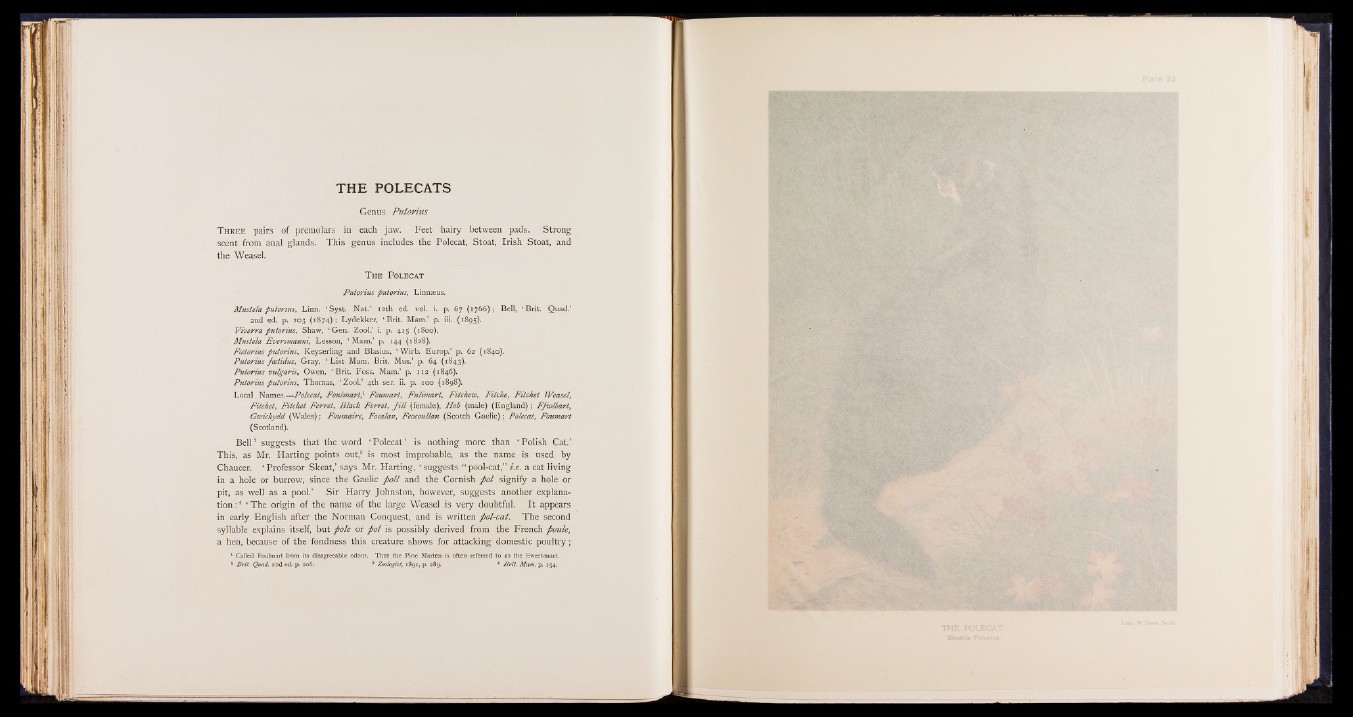
THE POLECATS
Genus Putorius
T hree pairs of premolars in each jaw. Feet hairy between pads. Strong
scent from anal glands. This genus includes the Polecat, Stoat, Irish Stoat, and
the Weasel.
T he Polecat
Putorius putorius, Linnaeus.
Mustela put onus, Linn. ‘ Syst. Nat’ 12th ed. vol. i. p. 67 (1766); Bell, ‘ Brit. Quad.’
2nd ed. p. 203 (1874); Lydekker, ‘ Brit. Mam.’ p. iii. (1895).
Viverra putorius, Shaw, ‘ Gen. Zool.’ i. p. 415 (1800).
Mustela Eversmanni, Lesson, ‘ Mam.’ p. 144 (1828).
Fcetorius putorius, Keyserling and Blasius, ‘Wirb. Europ.’ p. 62 (1840).
Putorius fcetidus, Gray, ‘ List Mam. Brit. Mus.’ p. 64 (1843).
Putorius vulgaris, Owen, ‘ Brit. Foss. Mam.’ p. 112 (1846).
Putorius putorius, Thomas, ‘ Zool.’ 4th ser. ii. p. 100 (1898).
Local Names.—Polecat, Foul-mart,* Foumart, Fulimart, Fitchew, Fitche, Fitchet Weasel,
Fitchet, Fitchet Ferret, Black Ferret, J ill (female), Hob (male) (England); Ffwlbart,
Gwichydd (Wales); Foumaire, Focalan, Feocoullan (Scotch Gaelic); Polecat, Foumart
(Scotland).
Bell2 suggests that the word ‘ Polecat ’ is nothing more than ‘ Polish Cat.’
This, as Mr. Harting points out,3 is most improbable, as the name is used by
Chaucer. ‘ Professor Skeat,’ says Mr. Harting, ‘ suggests “ pool-cat,” i.e. a cat living
in a hole or burrow, since the Gaelic p o ll and the Cornish p o l signify a hole or
pit, as well as a pool.’ Sir Harry Johnston, however, suggests another explanation
:4 * The origin of the name of the large Weasel is very doubtful. It appears
in early English after the Norman Conquest, and is written pol-cat. The second
syllable explains itself, but po le or p o l is possibly derived from the French poule,
a hen, because of the fondness this creature shows for attacking domestic poultry;
1 Called Foulmart from its disagreeable odour. Thus the Pine Marten is often referred to as the Sweet-mart.
* Brit. Quad. 2nd ed. p. 206. 3 Zoologist, 1891, p. 289. 4 Brit. Mam. p. 154.